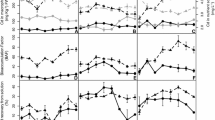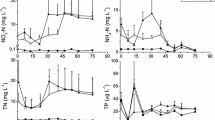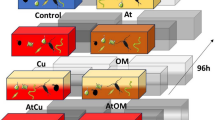Abstract
Pulse inputs of heavy metals are expected to increase with a higher frequency of extreme climate events (heavy rain), leading to stronger erosion of contaminated and fertilized farmland soils to freshwaters, with potentially adverse effects on lake ecosystems. We conducted a 5-month mesocosm study to elucidate the responses of the submerged macrophyte Vallisneria spinulosa and phytoplankton to four different doses of cadmium (Cd): 0 (control), 0.05, 0.5, and 5 g m−2 (CK, I, II, and III, respectively) under mesotrophic conditions. We found that total phosphorus concentrations were larger in the three Cd pulse treatments, whereas total nitrogen concentrations did not differ among the four treatments. The contents of chlorophyll a and soluble sugar in macrophyte leaves decreased in III, and total biomass, ramet number, plant height, and total stolon length of macrophytes were lower in both II and III. In contrast, abundances of the three main phytoplankton taxa—Cyanophyta, Chlorophyta, and Bacillariophyta—did not differ among treatments. Total phytoplankton biomass was, however, marginally lower in CK than in the Cd treatments. We conclude that exposure to strong Cd pulses led to significantly reduced growth of macrophytes, while no obvious effect appeared for phytoplankton.



Similar content being viewed by others
References
Andresen E, Mattusch J, Wellenreuther G, Thomas G, Arroyo Abad U, Kupper H (2013) Different strategies of cadmium detoxification in the submerged macrophyte Ceratophyllum demersum L. Metallomics 5:1377–1386. doi:10.1039/C3MT00088E
Andresen E et al (2016) Cadmium toxicity investigated at the physiological and biophysical levels under environmentally relevant conditions using the aquatic model plant Ceratophyllum demersum. New Phytol 210:1244–1258. doi:10.1111/nph.13840
Brand LE, Sunda WG, Guillard RRL (1986) Reduction of marine phytoplankton reproduction rates by copper and cadmium. J Exp Mar Bio Ecol 96:225–250. doi:10.1016/0022-0981(86)90205-4
Cao T, Xie P, Li ZQ, Ni LY, Zhang M, Xu J (2009) Physiological stress of high NH4 + concentration in water column on the submersed macrophyte Vallisneria natans L. Bull Environ Contam Toxicol 82:296–299. doi:10.1007/s00128-008-9531-5
Communique of the National Soil Pollution Survey (2014) URL: http://www.mlr.gov.cn/xwdt/jrxw/201404/t20140417_1312998.htm
Cullen JT, Maldonado MT (2013) Biogeochemistry of cadmium and its release to the environment. In: Sigel A, Sigel H, Sigel RKO (eds) Cadmium: from toxicity to essentiality. Springer Netherlands, Dordrecht, pp 31–62. doi:10.1007/978-94-007-5179-8_2
Dalla Vecchia F, Rocca NL, Moro I, De Faveri S, Andreoli C, Rascio N (2005) Morphogenetic, ultrastructural and physiological damages suffered by submerged leaves of Elodea canadensis exposed to cadmium. Plant Sci 168:329–338. doi:10.1016/j.plantsci.2004.07.025
Deng G, Li M, Li H, Yin LY, Li W (2014) Exposure to cadmium causes declines in growth and photosynthesis in the endangered aquatic fern (Ceratopteris pteridoides). Aquat Bot 112:23–32. doi:10.1016/j.aquabot.2013.07.003
DuBois M, Gilles KA, Hamilton JK, Rebers PA, Smith F (1956) Colorimetric method for determination of sugars and related substances. Anal Chem 28:350–356. doi:10.1021/ac60111a017
Duc Phuc H et al (2016) A 28-year observational study of urinary cadmium and β2-microglobulin concentrations in inhabitants in cadmium-polluted areas in Japan. J Appl Toxicol 36:1622–1628. doi:10.1002/jat.3327
Echeveste P, Agustí S, Tovar-Sánchez A (2012) Toxic thresholds of cadmium and lead to oceanic phytoplankton: cell size and ocean basin–dependent effects. Environ Toxicol Chem 31:1887–1894. doi:10.1002/etc.1893
Fathi AA, El-Shahed AM, Shoulkamy MA, Ibraheim HA, Abdel Rahman OM (2008) Response of Nile water phytoplankton to the toxicity of cobalt, copper and zinc. Research Journal of Environmental Toxicology 2:67–76
Field CB, Barros VR, Mach K, Mastrandrea M (2014) Climate change 2014: impacts, adaptation, and vulnerability. Contribution of working group II to the 5th assessment report of the intergovernmental panel on climate change. Cambridge University Press, New York
Godt J, Scheidig F, Grosse-Siestrup C, Esche V, Brandenburg P, Reich A, Groneberg DA (2006) The toxicity of cadmium and resulting hazards for human health. J Occup Med Toxicol (London, England) 1:22. doi:10.1186/1745-6673-1-22
Huang XF, Chen WM, Cai QM (1999) Survey, observation and analysis of lake ecology. Standards Press of China, Beijing (in Chinese)
Jain CK, Sharma MK (2002) Adsorption of cadmium on bed sediments of river Hindon: adsorption models and kinetics. Water Air Soil Pollut 137:1–19. doi:10.1023/a:1015530702297
Jensen A, Bro-Rasmussen F (1992) Environmental cadmium in Europe. In: Ware GW (ed) Reviews of environmental contamination and toxicology: continuation of residue reviews. Springer New York, New York, pp 101–181. doi:10.1007/978-1-4612-2890-5_3
Jeppesen E, Sondergaard M, Sondergaard M, Christofferson K (1998) The structuring role of submerged macrophytes in lakes. Ecological studies. Springer New York, New York
John R, Ahmad P, Gadgil K, Sharma S (2008) Effect of cadmium and lead on growth, biochemical parameters and uptake in Lemna polyrrhiza L. Plant Soil Environ 54:262–270
Kabata-Pendias A (2010) Trace elements in soils and plants, 4th edn. Taylor & Francis, Boca Raton
Kirkham MB (2006) Cadmium in plants on polluted soils: effects of soil factors, hyperaccumulation, and amendments. Geoderma 137:19–32. doi:10.1016/j.geoderma.2006.08.024
Küpper H, Kochian LV (2010) Transcriptional regulation of metal transport genes and mineral nutrition during acclimatization to cadmium and zinc in the cd/Zn hyperaccumulator, Thlaspi caerulescens (Ganges population). New Phytol 185:114–129. doi:10.1111/j.1469-8137.2009.03051.x
Leung HM et al (2016) Monitoring and assessment of heavy metal contamination in a constructed wetland in Shaoguan (Guangdong Province, China): bioaccumulation of Pb, Zn, Cu and Cd in aquatic and terrestrial components. Environ Sci Pollut Res 24(10):9079–9088. doi:10.1007/s11356-016-6756-4
Li W, Zhang Z, Jeppesen E (2008) The response of Vallisneria spinulosa (Hydrocharitaceae) to different loadings of ammonia and nitrate at moderate phosphorus concentration: a mesocosm approach. Freshwat Biol 53:2321–2330. doi:10.1111/j.1365-2427.2008.02053.x
Miao AJ, Wang WX (2006) Cadmium toxicity to two marine phytoplankton under different nutrient conditions. Aquat Toxicol 78:114–126. doi:10.1016/j.aquatox.2006.02.008
Mishra S, Tripathi RD, Srivastava S, Dwivedi S, Trivedi PK, Dhankher OP, Khare A (2009) Thiol metabolism play significant role during cadmium detoxification by Ceratophyllum demersum L. Bioresour Technol 100:2155–2161. doi:10.1016/j.biortech.2008.10.041
Mishra S, Wellenreuther G, Mattusch J, Stärk H-J, Küpper H (2013) Speciation and distribution of arsenic in the nonhyperaccumulator macrophyte Ceratophyllum demersum. Plant Physiol 163:1396–1408. doi:10.1104/pp.113.224303
Nawrot T et al (2006) Environmental exposure to cadmium and risk of cancer: a prospective population-based study. Lancet Oncol 7:119–126. doi:10.1016/S1470-2045(06)70545-9
Payne CD, Price NM (1999) Effects of cadmium toxicity on growth and elemental compostion of marine phytoplankton. J Phycol 35:293–302. doi:10.1046/j.1529-8817.1999.3520293.x
Prozialeck WC, Edwards JR (2012) Mechanisms of cadmium-induced proximal tubule injury: new insights with implications for biomonitoring and therapeutic interventions. J Pharmacol Exp Ther 343:2–12. doi:10.1124/jpet.110.166769
Ruangsomboon S, Wongrat L (2006) Bioaccumulation of cadmium in an experimental aquatic food chain involving phytoplankton (Chlorella vulgaris), zooplankton (Moina macrocopa), and the predatory catfish Clarias macrocephalus × C. gariepinus. Aquat Toxicol 78:15–20. doi:10.1016/j.aquatox.2006.01.015
Søndergaard M, Johansson LS, Lauridsen TL, Jørgensen TB, Liboriussen L, Jeppesen E (2010) Submerged macrophytes as indicators of the ecological quality of lakes. Freshwat Biol 55:893–908. doi:10.1111/j.1365-2427.2009.02331.x
Wagner GJ (1993) Accumulation of cadmium in crop plants and its consequences to human health. In: Donald LS (ed) Advances in agronomy. Academic, Cambridge, pp 173–212. doi:10.1016/S0065-2113(08)60593-3
Wang HJ, Wang HZ, Liang XM, Wu SK (2014) Total phosphorus thresholds for regime shifts are nearly equal in subtropical and temperate shallow lakes with moderate depths and areas. Freshwat Biol 59:1659–1671. doi:10.1111/fwb.12372
Xie LQ, Xie P, Li SX, Tang HJ, Liu H (2003) The low TN:TP ratio, a cause or a result of Microcystis blooms? Water Res 37:2073–2080. doi:10.1016/S0043-1354(02)00532-8
Xing W, Wu HP, Hao BB, Huang WM, Liu GH (2013) Bioaccumulation of heavy metals by submerged macrophytes: looking for hyperaccumulators in eutrophic lakes. Environ Sci Technol 47:4695–4703. doi:10.1021/es303923w
Yabanli M, Yozukmaz A, Sel F (2014) Heavy metal accumulation in the leaves, stem and root of the invasive submerged macrophyte Myriophyllum spicatum L. (Haloragaceae): an example of Kadin Creek (Mugla, Turkey). Braz Arch Biol Technol 57:434–440
Yang ZF, Wang Y, Shen ZY et al (2009) Distribution and speciation of heavy metals in sediments from the mainstream, tributaries, and lakes of the Yangtze River catchment of Wuhan, China. J Hazard Mater 166:1186–1194
Zhang Z, Cao Y, Jeppesen E, Li W (2016) The response of Vallisneria spinulosa (Hydrocharitaceae) and plankton to pulse addition of inorganic nitrogen with different loading patterns. Hydrobiologia 767:175–184. doi:10.1007/s10750-015-2494-8
Acknowledgements
This study was supported by the National Natural Science Foundation of China (31601824, 51379133), CRES (Danish Strategic Research Council), CLEAR (a Villum Kann Rasmussen Centre of Excellence project), and the MARS project (Managing Aquatic ecosystems and water Resources under multiple Stress) funded under the 7th EU Framework Programme, Theme 6 (Environment including Climate Change), Contract No.: 603378 (http://www.mars-project.eu). We thank Anne Mette Poulsen for valuable editorial comments.
Author information
Authors and Affiliations
Corresponding author
Additional information
Responsible editor: Elena Maestri
Rights and permissions
About this article
Cite this article
Liu, H., Cao, Y., Li, W. et al. The effects of cadmium pulse dosing on physiological traits and growth of the submerged macrophyte Vallisneria spinulosa and phytoplankton biomass: a mesocosm study. Environ Sci Pollut Res 24, 15308–15314 (2017). https://doi.org/10.1007/s11356-017-9155-6
Received:
Accepted:
Published:
Issue Date:
DOI: https://doi.org/10.1007/s11356-017-9155-6




